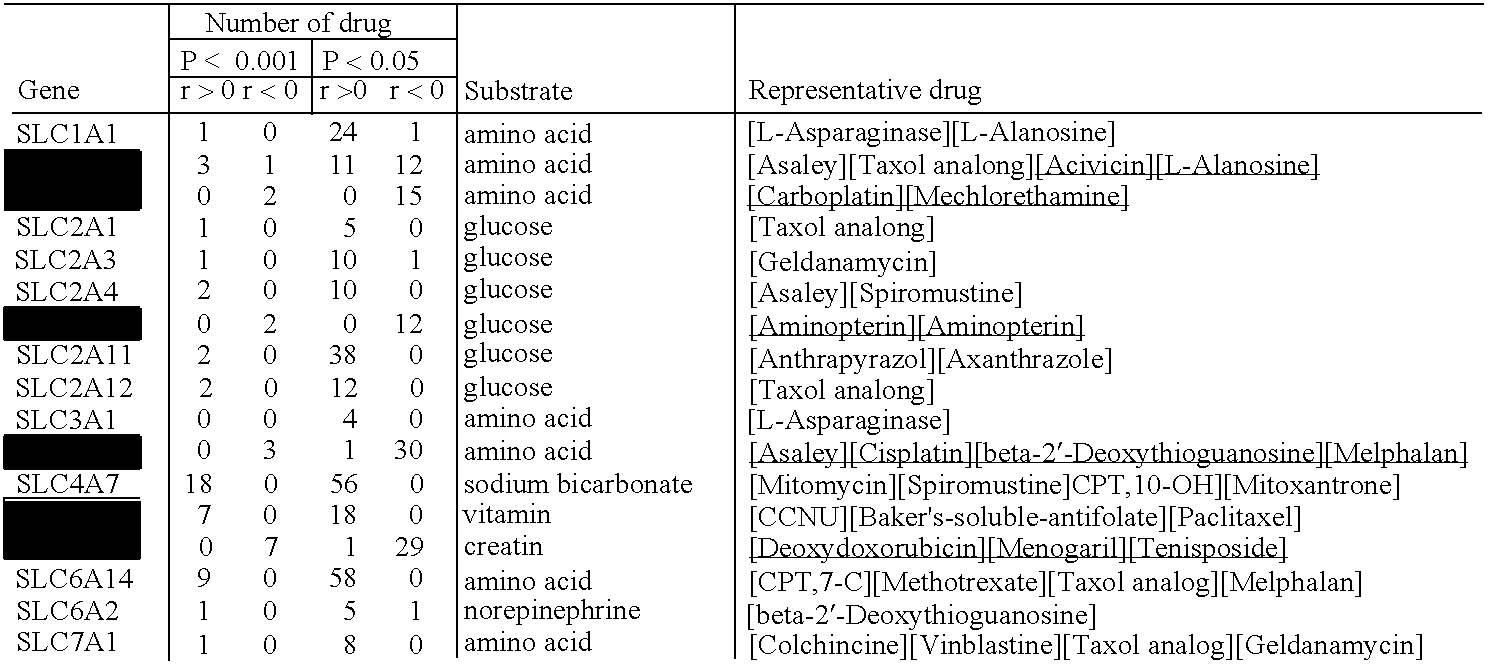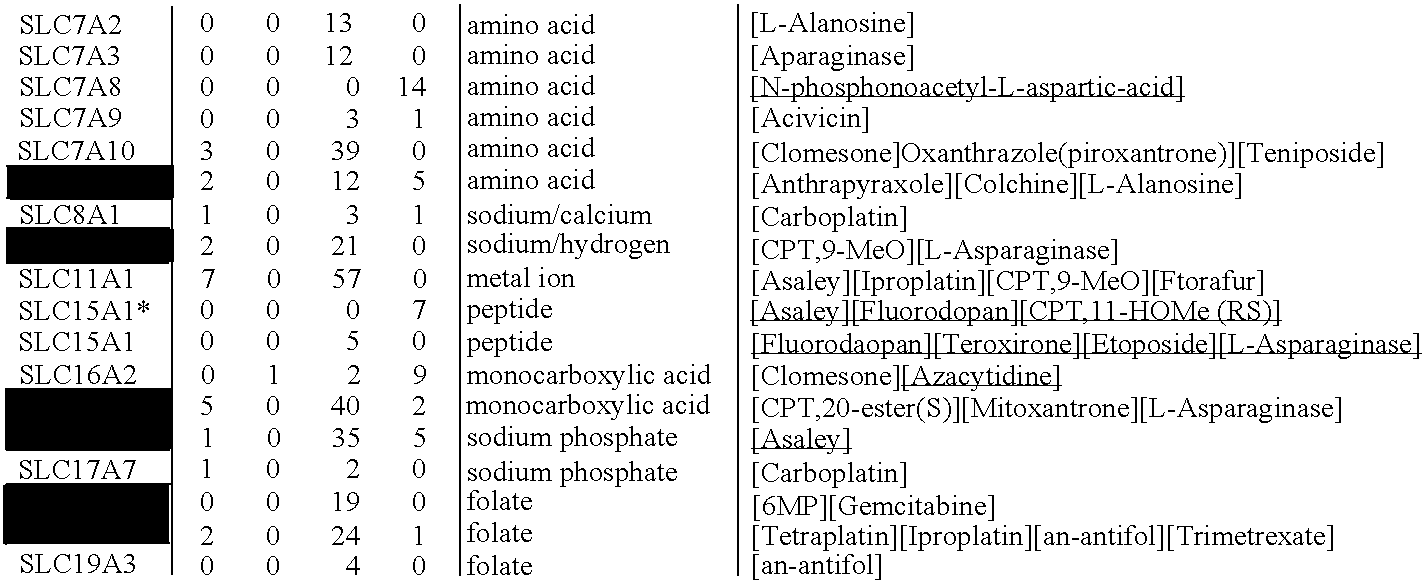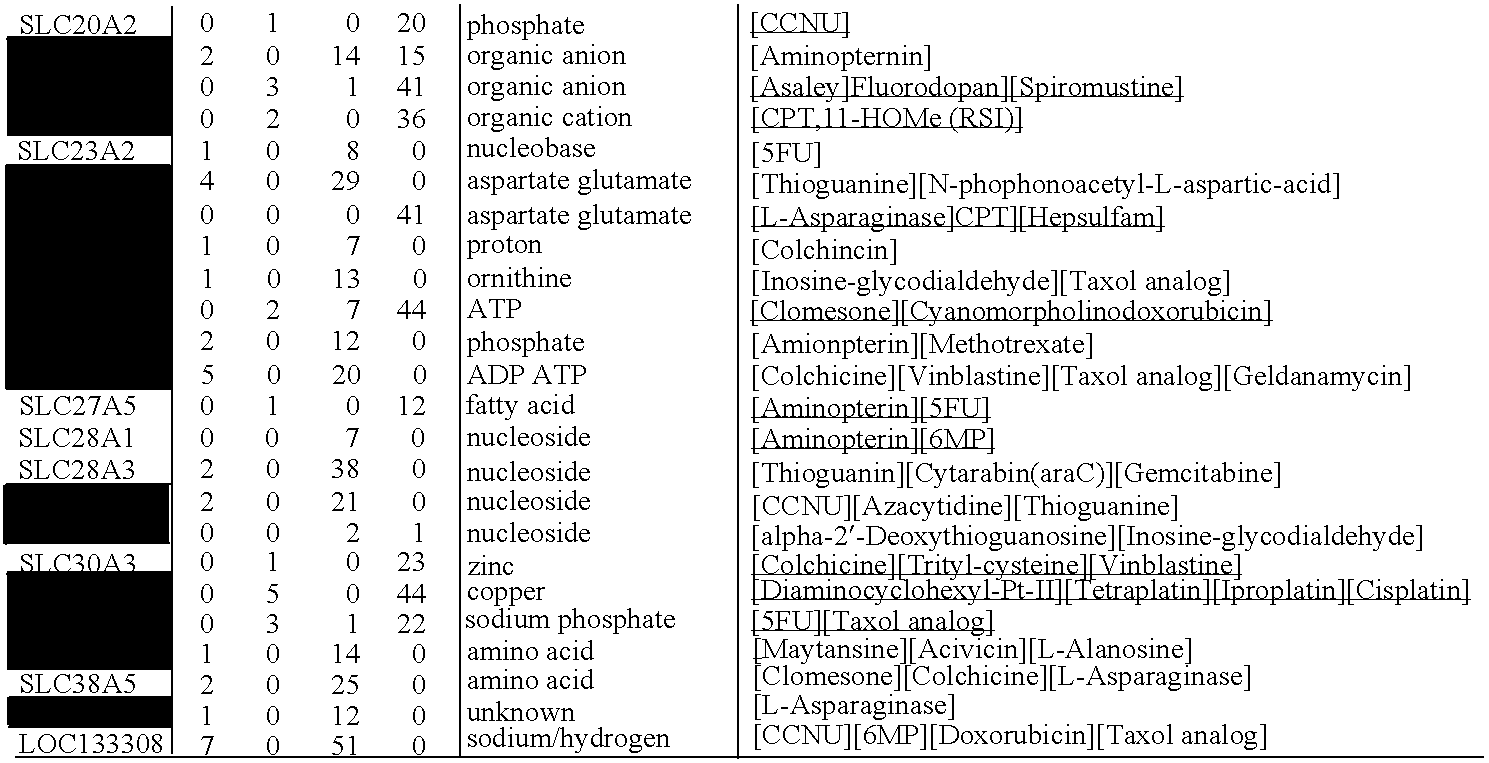Determining the chemosensitivity of cells to cytotoxic agents
a technology of cytotoxic agents and cytotoxic agents, applied in biochemistry apparatus and processes, specific use bioreactors/fermenters, biomass after-treatment, etc., can solve the problems of lack of tools for profiling genetic factors influencing sensitivity and resistance, few treatment options, treatment failure, etc., and achieve the effect of modulating the chemosensitivity of a cancer
- Summary
- Abstract
- Description
- Claims
- Application Information
AI Technical Summary
Benefits of technology
Problems solved by technology
Method used
Image
Examples
example 1
Identification of Chemosensitivity Gene Drug Correlations
[0082] Gene-Drug Correlations:Gene expression profiles of membrane transporters and channels were compared with potency of 119 drugs in the NCI60 panel of cancer cells shown in Table A.
TABLE ANCI60 Cancer Cell Lines (12 reference pool lines)ColonRenalOvarianMelanomaCNSLeukemiaBreastLungβCOLO205786-0IGROV1βLOXIMVISF-268CCRF-CEMβMCF7A549 / HCC-2998A498βOVCAR-3MALME-3MSF-295βHL-60(TB)NCI / ADR-ATCCHCT-116ACHNβOVCAR-4M14SF-539βK-562RESEKVXHCT-15βCAKI-1VCAR-5SK-MEL-2βSNB-19MOLT-4MDA-MB-231 / HOP-62HT29RXF393VCAR-8SK-MEL-28SNB-75RPMI-8226ATCCHOP-92KM12SN12CSK-OV-3SK-MEL-5U251SRβHS578TβNCI-H226SW-620TK-10UACC-257ProstateMDA-MB-435NCI-H23UO-31UACC-62βPC-3MDA-NNCI-H322MDU-145BT-549NCI-H460T-47NCI-H522
[0083] Gene expression and chemo-sensitivity were analyzed and chemosensitivity genes were identified by employing correlation analysis according to the method of Scherf et al. that combined genome-wide expression profiling with drug activity...
example 2
Solute Carriers (SLCs) and Chemosensitivity
[0093] Solute carriers encode the transportome for amino acids, peptides, sugars, monocarboxylic acid, organic cations, phosphates, nucleosides and water-soluble vitamins. Table 1 and FIG. 1 summarize the results for select SLC genes that showed significant Pearson correlation for at least one drug. Several identified transporters have previously been implicated in drug transport or they transport natural substrates similar in structure to correlated drugs. Thus, nucleobase transporters (SLC23A2) and nucleoside transporters of both ENT (equilibrative) and CNT (concentrative) families showed positive correlations with a number of drug analogues (FIG. 1a), as expected for transporters that facilitate drug entry into cells. For example, SLC29A1 (equilibrative nucleoside transporter 1, ENT1) positively correlated with azacytidine (FIG. 1a) and ENT2 with alpha-2′-deoxythioguanosine, consistent with the notion that these transporters are essenti...
example 3
ABC Transporters and Chemoresistance
[0098] Among 40 genes tested that encode ABC transporters, 11 showed negative correlations (Table 2). Nine of these genes had been previously implicated in drug resistance. Only four genes showed highly significant negative correlations (P<0.001). Expression data obtained by other methods validated results for three of these genes (ABCB1, ABCC3, and ABCB5—a putative novel resistance gene) (Table 2).
[0099] Expression levels of ABCB1 (or MDR1, Pgp) significantly correlated with potency of many drugs (Table 1). A plot of the ordered ABCB1 correlation coefficients for all 119 drugs revealed a clear separation between known ABCB1 substrates and non-substrates (FIG. 2). Using the dual criteria of P<0.05 and r<−0.3, we identified all known substrates of ABCB1 plus geldanamycin (GA) (NSC 330500) and Baker's-soluble-antifol (BAF) (NSC 139105) (Table 2). These results were validated by silencing of ABCB1 gene expression using RNA interference (RNAi) (see ...
PUM
| Property | Measurement | Unit |
|---|---|---|
| Area | aaaaa | aaaaa |
| Length | aaaaa | aaaaa |
| Electrical resistance | aaaaa | aaaaa |
Abstract
Description
Claims
Application Information
 Login to View More
Login to View More - R&D
- Intellectual Property
- Life Sciences
- Materials
- Tech Scout
- Unparalleled Data Quality
- Higher Quality Content
- 60% Fewer Hallucinations
Browse by: Latest US Patents, China's latest patents, Technical Efficacy Thesaurus, Application Domain, Technology Topic, Popular Technical Reports.
© 2025 PatSnap. All rights reserved.Legal|Privacy policy|Modern Slavery Act Transparency Statement|Sitemap|About US| Contact US: help@patsnap.com



